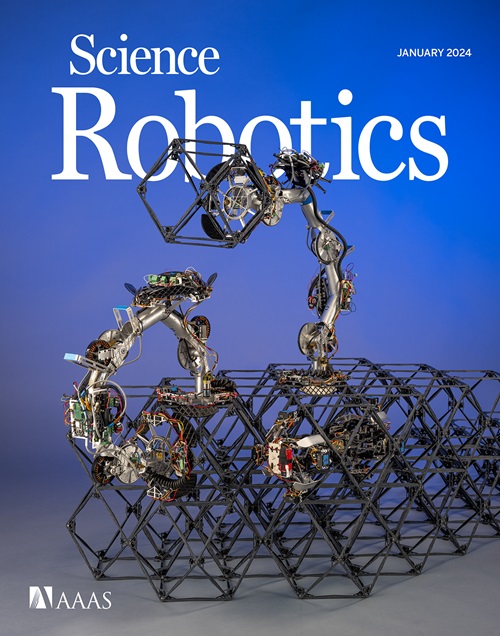利用合作机器人长期自主跟踪蜜蜂行为
IF 26.1
1区 计算机科学
Q1 ROBOTICS
引用次数: 0
摘要
数字化和机电一体化方法与人工智能和机器学习相结合,是行为科学和生物学领域的变革性技术。最重要的授粉物种--蜜蜂--的核心要素是蜂群的蜂王。由于蜜蜂的自我调节非常复杂,而且在自然蜂群环境中研究蜂王非常困难,因此这些生物的行为策略尚未得到广泛研究。我们创建了一个自主机器人观察和行为分析系统,旨在对蜂王及其与工蜂和蜂巢细胞的互动进行持续观察,从而生成长度和质量都非常高的行为数据集。我们的机器人系统收集了蜂王的关键行为指标及其在蜂群中的社会嵌入情况。在 30 天的时间里,我们每天 24 小时不间断地收集数据,证明了我们的系统有能力提取微观、中观和宏观系统层面的关键行为指标。此外,还对蜂王、工蜂和雏蜂之间的互动进行了观察和量化。机器人进行的长期连续观测产生了大量高清视频数据,这是人类或固定摄像机无法观测到的。我们的机器人系统可以让人们更深入地了解蜜蜂蜂群智能自我调节的内在机制。此外,它还为以自动化方式研究其他社会性昆虫群落、生物群落和生态系统提供了可能。社会性昆虫是所有陆地生态系统中的关键物种;因此,更好地了解它们的行为对于保护甚至恢复全球脆弱的生态系统将是非常有价值的。本文章由计算机程序翻译,如有差异,请以英文原文为准。
Autonomous tracking of honey bee behaviors over long-term periods with cooperating robots
Digital and mechatronic methods, paired with artificial intelligence and machine learning, are transformative technologies in behavioral science and biology. The central element of the most important pollinator species—honey bees—is the colony’s queen. Because honey bee self-regulation is complex and studying queens in their natural colony context is difficult, the behavioral strategies of these organisms have not been widely studied. We created an autonomous robotic observation and behavioral analysis system aimed at continuous observation of the queen and her interactions with worker bees and comb cells, generating behavioral datasets of exceptional length and quality. Key behavioral metrics of the queen and her social embedding within the colony were gathered using our robotic system. Data were collected continuously for 24 hours a day over a period of 30 days, demonstrating our system’s capability to extract key behavioral metrics at microscopic, mesoscopic, and macroscopic system levels. Additionally, interactions among the queen, worker bees, and brood were observed and quantified. Long-term continuous observations performed by the robot yielded large amounts of high-definition video data that are beyond the observation capabilities of humans or stationary cameras. Our robotic system can enable a deeper understanding of the innermost mechanisms of honey bees’ swarm-intelligent self-regulation. Moreover, it offers the possibility to study other social insect colonies, biocoenoses, and ecosystems in an automated manner. Social insects are keystone species in all terrestrial ecosystems; thus, developing a better understanding of their behaviors will be invaluable for the protection and even the restoration of our fragile ecosystems globally.
求助全文
通过发布文献求助,成功后即可免费获取论文全文。
去求助
来源期刊

Science Robotics
Mathematics-Control and Optimization
CiteScore
30.60
自引率
2.80%
发文量
83
期刊介绍:
Science Robotics publishes original, peer-reviewed, science- or engineering-based research articles that advance the field of robotics. The journal also features editor-commissioned Reviews. An international team of academic editors holds Science Robotics articles to the same high-quality standard that is the hallmark of the Science family of journals.
Sub-topics include: actuators, advanced materials, artificial Intelligence, autonomous vehicles, bio-inspired design, exoskeletons, fabrication, field robotics, human-robot interaction, humanoids, industrial robotics, kinematics, machine learning, material science, medical technology, motion planning and control, micro- and nano-robotics, multi-robot control, sensors, service robotics, social and ethical issues, soft robotics, and space, planetary and undersea exploration.
 求助内容:
求助内容: 应助结果提醒方式:
应助结果提醒方式:


